冀教版七年级英语上册unit 3《lesson 17 seeing a doctor》ppt课件
- 格式:ppt
- 大小:5.94 MB
- 文档页数:26

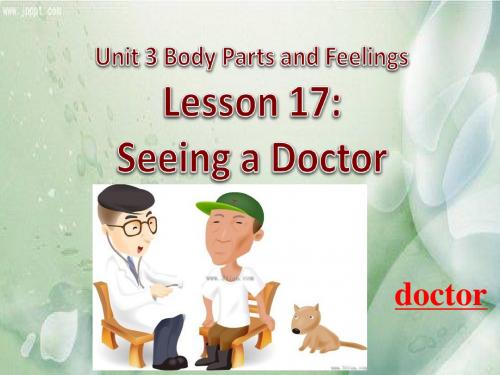
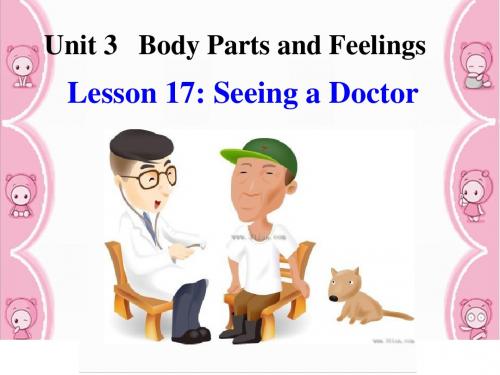
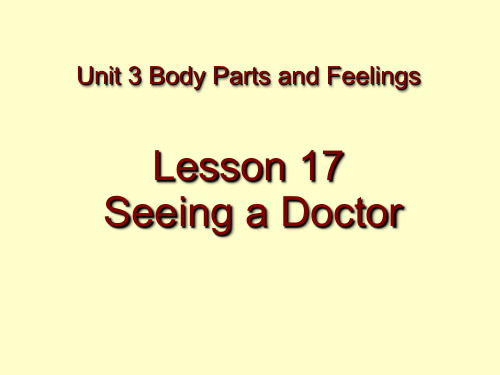
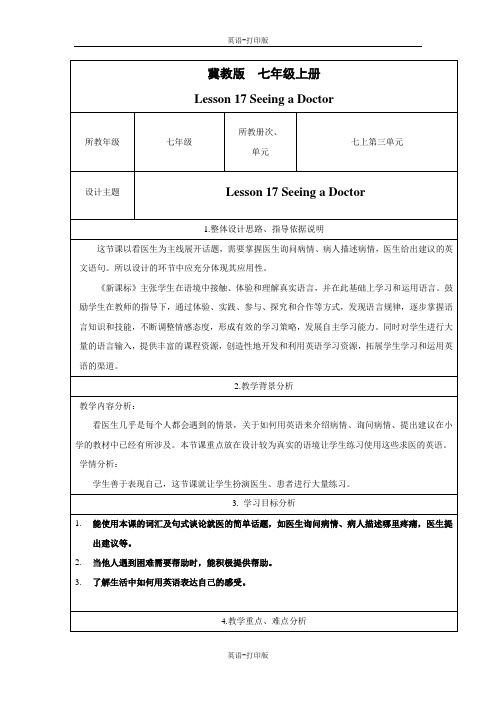
教学重点:1. 能自如地用How do you feel? What's wrong? What's the matter? 询问病情,并给予回答。
2. 学会had better do 的用法。
教学难点:医患之间的对话。
5.教学过程设计步骤1:Warm upHave a free talk with the students, then teach them the new words and expressions.设计意图:通过聊天使学生以愉快、放松的心情投入本节课的英语学习,吸引学生的注意力,激发他们的好奇心,同时巧妙地引出本课生词。
步骤2:出示学习目标。
设计意图:做到有的放矢,清楚本节课要完成的任务和途经。
步骤3:学习生词。
通过语篇,引出生词及重点短语。
stomachache n. 肚子痛;胃痛The man has a stomachache.=The man’s stomach hurts.=The man has a pain in his stomach.What should you do when you have a stomachache?better adj. &adv. (good/well的比较级)更好的(地)Good, better, best,Never let it rest,Till good is better,And better, best.matter n. 问题1. Don't you think this is now a matter for the police?...难道你不觉得这件事现在该交由警方处理吗?2. Age doesn’t matter. 年龄不是问题。
3. What’s the matter with …?headache n. 头痛She has a bad headache when she thinks of her homework. She had a headache after eating the food.medicine n. 药My mother had a bad cold yesterday. She had some medicine and went to bed. She became better and better after that.stay v. 停留;留下;待一段时间rest v. &n. 休息The boy coughed a lot last night. Now he stays home and has a good rest. He should drink plenty of water.设计意图:通过图片引出stomachache,通过介绍孩子肚子疼,该怎么办,引出had better,通过一首小诗,了解better的含义,然后介绍了头疼等的词汇及看医生常用到的句式。
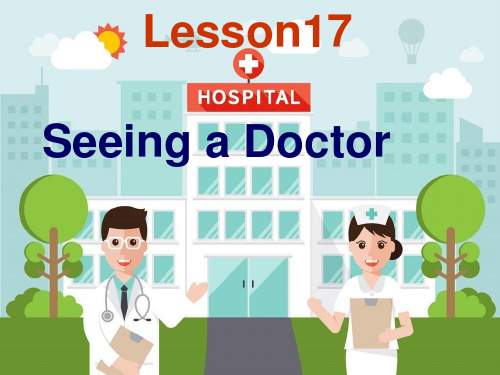
Lesson 17: Seeing a Doctor教学设计白银市第六中学李菊霞一、Analysis of the LessonThis is the fifth lesson of unit 3 Body Parts. In this class, the teacher should teach students something about seeing a doctor. For example:I have a headache. This lesson is very important in Unit 3 and also very essential in oral English. So helping students master the key points is critical in this lesson.二、The Analysis of studentsThese students are new in middle school. And some of them know little about English. By learning unit 1&unit 2, they get familiar with some simple English words and they can use English to describe their own feelings. So in this lesson, the teacher should attract their attention by doing some interesting activities and also praise the students more often. Thus the students will be interested in learning English.三、Teaching Content1. Master these new words: Matter, headache, medicine, rest, stay...2. Master Useful sentences: How do you feel? What’s the matter? I have a headache/cold四、Teaching AimsAim of knowledge1. Master these new words : Matter, headache, medicine ,rest, stay...2. Master useful sentences: How do you feel? What’s the matter? I have a headache/cold. You ‘d better (not) do...(giving advice).Aim of abilityThe students are able to talk about their sickness in English when seeing a doctor.Aim of emotionStudents learn to offer their partners necessary help or good advice when they are in trouble.五、Important Points in TeachingUseful sentences: How do you feel? What’s the matter? I have a headache/cold. His/Her arm/leg hurts.How to describe your sickness and talk with a doctor in English when you are illDifficult Points in TeachingHow to describe your sickness and talk with a doctor in English when you are ill六、Teaching AidsElectronic whiteboard, power point, audio,video.Step1. Warming up and Lead- in1.Greetings:Ask and answer: Express the feelings of yourself.Let some students answer and ask questions like this.How do you feel? I feel …Are you happy? I am happy/sad…Are you hot or cold? I feel…2.A student is late for class, he feels sick, he has a stomachache.He had better go to see a doctor after class.(情景导入)Step2. Presentation1. By looking at some pictures and doing actions to help students guess “What’s wrong with him/her?” And then ask students guess “what should they do?”Present some new words and phrases, such assee a doctor, have a headache/... Take the medicine...2. read the new words and phrases after the teacher.3. (Practice) Let’s check who has the best memory.Part 1Step3. ListeningLook at the pictures and let students first guess “Who are they?” and “How do they feel?”Then play the audio of part 1 and ask students to listen carefully, find the answers to the questions.Step4. Reading1.Ask students to read the dialogue twice together.2.Pair work. Ask two or three pairs to act the dialogue out.3.Discuss: If your classmates or friends are ill, they had better go tosee a doctor. What should the doctor say to them?Part 2Step 5 . ReadingLook at the picture of Danny, he goes to see a doctor. Can you guess “What’s the matter with him?” and “What does the doctor say to him?”Have students read part 2 and find the answers.Step 6 . Listening1. Ask students to listen to part 2 carefully, pay attention to thepronunciation and intonation.2. Have them read part 2 in roles. Ask several pairs to show their dialogue, and see which pair reads the best.Step 7 . PracticeShow three pictures on the white board, let students talk about them in groups, and give each person some advice by using sentence structure: You had better (not) do …Step 8 . Group work (acting)1. First, watch a video about seeing a doctor.2. Make up a new dialogue about seeing a doctor just like what you see in the video. (How to talk with the doctor about one’s sickness in English?)Step 9 . ConsolidationStudents are asked to do some exercises to consolidate what they have learned in this lesson.Step 10 . Homework (writing) (二选一,分层次作业)1. Make up a new dialogue about seeing a doctor and write it down.2.If your friend Lucy feels sick, please write a letter and give her some advice.Step 10. Blackboard designWhat’s the matter with him/...? He/ She has a headache/...How do you feel? I feel...You ’d better take the medicine, stay home and have a good rest. You had better (not) do …。